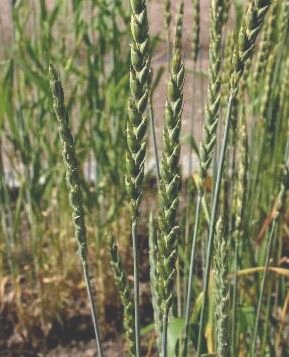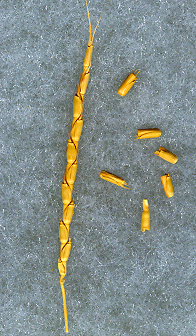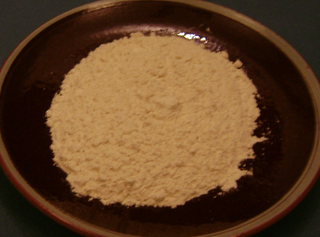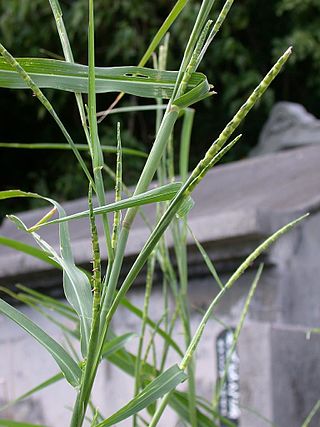
Einkorn wheat is either a wild species of wheat (Triticum) or its domesticated form. The wild form is T. boeoticum, and the domesticated form is T. monococcum. Einkorn is a diploid species of hulled wheat, with tough glumes (husks) that tightly enclose the grains. The cultivated form is similar to the wild, except that the ear stays intact when ripe and the seeds are larger. The domestic form is known as petit épeautre in French, Einkorn in German, "einkorn" or "littlespelt" in English, piccolo farro in Italian and escanda menor in Spanish. The name refers to the fact that each spikelet contains only one grain.

Alopecurus, or foxtail grass, is a common and widespread genus of plants in the grass family. It is common across temperate and subtropical parts of Eurasia, northern Africa, and the Americas, as well as naturalized in Australia and on various islands.

Spelt, also known as dinkel wheat or hulled wheat, is a species of wheat. It is a relict crop, eaten in Central Europe and northern Spain. It is high in protein and may be considered a health food.

Agropyron is a genus of Eurasian plants in the grass family), native to Europe and Asia but widely naturalized in North America.

Common wheat, also known as bread wheat, is a cultivated wheat species. About 95% of wheat produced worldwide is common wheat; it is the most widely grown of all crops and the cereal with the highest monetary yield.

During 10,000 years of cultivation, numerous forms of wheat, many of them hybrids, have developed under a combination of artificial and natural selection. This diversity has led to much confusion in the naming of wheats. Genetic and morphological characteristics of wheat influence its classification; many common and botanical names of wheat are in current use.

Triticeae is a botanical tribe within the subfamily Pooideae of grasses that includes genera with many domesticated species. Major crop genera found in this tribe include wheat, barley, and rye; crops in other genera include some for human consumption, and others used for animal feed or rangeland protection. Among the world's cultivated species, this tribe has some of the most complex genetic histories. An example is bread wheat, which contains the genomes of three species with only one being a wheat Triticum species. Seed storage proteins in the Triticeae are implicated in various food allergies and intolerances.

Brachypodium is a genus of plants in the grass family, widespread across much of Africa, Eurasia, and Latin America. The genus is classified in its own tribe Brachypodieae.

Aegilops crassa is an ornamental plant in the family Poaceae. It is referred to by the common name Persian goatgrass. It is native to Afghanistan, Iran, Iraq, Kazakhstan, Kyrgyzstan, Lebanon, Palestine, Syria, Tajikistan, Transcaucasia, Turkey, Turkmenistan, and Uzbekistan.

Aegilops cylindrica, also known as jointed goatgrass, is an annual grass seed native to Southern Europe and Russia that is part of the tribe Triticeae, along with wheat and some other cereals. It is not native to North America, however it has become a serious issue as a weed since it was introduced in the late 19th century. Due to its relation to winter wheat, it is very difficult to control. Not only are the grains similar in shape and size to the seeds of winter wheat, making it difficult to remove through grain cleaning methods, the shared genetics mean that no registered herbicides are available to single out jointed goatgrass while leaving winter wheat unharmed. This poses problems for farmers who have to suffer through reduced yields and poorer quality winter wheat.

Aegilops tauschii, the Tausch's goatgrass or rough-spike hard grass, is an annual grass species. It is native to Crimea, the Caucasus region, western and Central Asia, Afghanistan, Pakistan, the western Himalaya, and parts of China, and has been introduced to other locales, including California.
Aegilops kotschyi is a member of the grass family, Poaceae, native to the Levant.

Aegilops umbellulata, the umbel goatgrass, is an annual grass that is closesly related to wheat. It is native to southeastern Europe, Iran, Iraq, Lebanon, Syria, the Transcaucasus, and Turkey.

Aegilops triuncialis, or barbed goatgrass, is a grass species of the family Poaceae. It is a winter annual native to many areas in Eastern and Mediterranean Europe and Western Asia. It is considered an introduced, invasive species in North America, mainly in the Western coast of the United States. In its native lands, the grass thrives in mainly rocky, serpentine soil, but also does well in grasslands and ruderal/disturbed ground as well as oak woodlands.

Gluten is the seed storage protein in mature wheat seeds. It is the sticky substance in bread wheat which allows dough to rise and retain its shape during baking. The same, or very similar, proteins are also found in related grasses within the tribe Triticeae. Seed glutens of some non-Triticeae plants have similar properties, but none can perform on a par with those of the Triticeae taxa, particularly the Triticum species. What distinguishes bread wheat from these other grass seeds is the quantity of these proteins and the level of subcomponents, with bread wheat having the highest protein content and a complex mixture of proteins derived from three grass species.
Ophiuros is a genus of Asia, Australian, and East African plants in the grass family.

Parapholis is a genus of Eurasian and North African flowering plants in the grass family.

Rottboellia is a genus of African, Asian, and Australian plants in the grass family.

Rottboellia cochinchinensis is a species of grass known by the common names Itchgrass,Raoul grass, corngrass, Kokoma grass, Guinea-fowl grass, jointed grass, Shamwa grass and Kelly grass. It is a tall, tufted annual grass whose stems (culms) grow up to 3 metres in height with leaf-blades of up to 45 centimetres in length. The species flowers at the apex of culms in the form of spike-like racemes composed of paired spikelets. The common name Itchgrass comes from the bristly (hispid) leaf-sheath which can be irritating to the skin.
× Aegilotriticum is a nothogenus of flowering plants in the family Poaceae. They are the result of crosses between species of two distinct grass genera, Aegilops (goatgrasses) and Triticum (wheat). This type of intergeneric hybridization is quite rare, and is indicated by a multiplication symbol before the name. The name Aegilotriticum is an example of a portmanteau word, a combination of the two parents' names. This genus has at least 7 species.



















